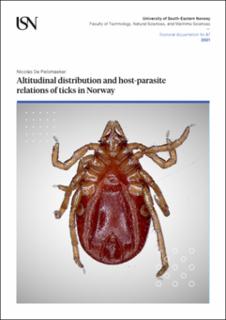| dc.contributor.author | De Pelsmaeker, Nicolas | |
| dc.coverage.spatial | Norway | en_US |
| dc.date.accessioned | 2021-03-17T14:21:37Z | |
| dc.date.available | 2021-03-17T14:21:37Z | |
| dc.date.issued | 2021-03-05 | |
| dc.identifier.isbn | 978-82-7206-586-6 | |
| dc.identifier.issn | 2535-5252 | |
| dc.identifier.uri | https://hdl.handle.net/11250/2733982 | |
| dc.description.abstract | With a warming climate and changes in land use during the last decades, ticks have been observed to occur at increasingly higher latitudes and altitudes in the northern hemisphere. With the range expansion of ticks comes the potential for new diseases to emerge in previously uninfected areas, as well the number of cases of existing ones to increase. The effects of climate change are expected to be disproportionally pronounced a high latitudes, and are expected to continue for the foreseeable future. However, the dynamics of tick range expansion and their altitudinal occurrence near their northern distribution limit remain poorly understood. This thesis examines the altitudinal occurrence and host-parasite relations of two tick species, the exophilic generalist Ixodes ricinus and the endophilic specialist I. trianguliceps, by investigating the burdens found on small mammals along two altitudinal gradients in two locations in southern Norway. Based on previous studies in Norway, the highest altitude at which I. ricinus was found was 583 m.a.s.l., but in this thesis we found that I. ricinus occur considerably higher than previously thought, up to an altitude of at least 1000 m.a.s.l. The effects of altitude were less pronounced on the occurrence of I. trianguliceps, indicating that the endophilic ecology of this species may enable it to survive at higher altitudes compared to the exophilic I. ricinus. A follow-up study expanding the range of the altitudinal gradient may reveal the actual distribution limit of ticks in these areas.
Furthermore, this study also investigated how ticks may utilize other hosts in areas characterized by multi-annual, high-amplitude rodent cycles, and how such cycles may inhibit the further progression of ticks. We found that non-cyclical shrew populations may have the potential to maintain tick populations in periods of low rodent availability, therefore enabling ticks to sustain a further upward progression, despite the periodic unavailability of some host species. A study encompassing one or more complete rodent cycles may shed more light on the roles of small mammals other than rodents in their capacity to act as a stable reserve of tick hosts, as well as on the specifics of the rodent cycles in these areas, and the influence of warming temperatures.
Lastly, we tested whether the choice of capture method (live or lethal trapping) may result in different perceived tick burdens, in order to determine whether the use of live trapping was unavoidable to accurately assess tick burdens. We found no significant differences in larval I. ricinus burdens on hosts captured between the two trap types, and we therefore propose that in light of animal welfare, lethal trapping of small mammals in studies assessing tick burdens is favored, as animals are not subjected to capture stress, while accuracy is maintained. The combined results in this thesis may serve as a starting point for further studies investigating the range expansion of ticks and tick-borne diseases in northern regions. | en_US |
| dc.language.iso | eng | en_US |
| dc.publisher | University of South-Eastern Norway | en_US |
| dc.relation.ispartofseries | Doctoral dissertations at the University of South-Eastern Norway;87 | |
| dc.relation.haspart | Paper I: De Pelsmaeker, N., Korslund, L. & Steifetten, Ø.: Do bank voles (Myodes glareolus) trapped in live and lethal traps show differences in tick burden? PLoS ONE 15(9), (2020), e0239029. https://doi.org/10.1371/journal.pone.0239029 | en_US |
| dc.relation.haspart | Paper II: De Pelsmaeker, N., Korslund, L. & Steifetten, Ø.: High-elevational occurrence of two tick species, Ixodes ricinus and I. trianguliceps, at their northern distribution range. Submitted to Parasites & Vectors | en_US |
| dc.relation.haspart | Paper III: De Pelsmaeker, N., Korslund, L. & Steifetten, Ø.: Host in reserve: the role of common shrews (Sorex araneus) as a stable supplementary source of hosts in small mammal communities influenced by rodent population cycles. Manuscript. Not available online | en_US |
| dc.rights.uri | http://creativecommons.org/licenses/by-nc-sa/4.0/deed.no | |
| dc.subject | climate | en_US |
| dc.subject | range shift | en_US |
| dc.subject | expansion | en_US |
| dc.subject | ticks | en_US |
| dc.subject | hosts | en_US |
| dc.subject | Ixodes ricinus | en_US |
| dc.subject | Ixodes trianguliceps | en_US |
| dc.subject | rodents | en_US |
| dc.subject | shrews | en_US |
| dc.subject | altitude | en_US |
| dc.title | Altitudinal distribution and host-parasite relations of ticks in Norway | en_US |
| dc.type | Doctoral thesis | en_US |
| dc.description.version | publishedVersion | en_US |
| dc.rights.holder | © The Author, except otherwise stated | en_US |
| dc.subject.nsi | VDP::Matematikk og Naturvitenskap: 400::Zoologiske og botaniske fag: 480::Økologi: 488 | en_US |

